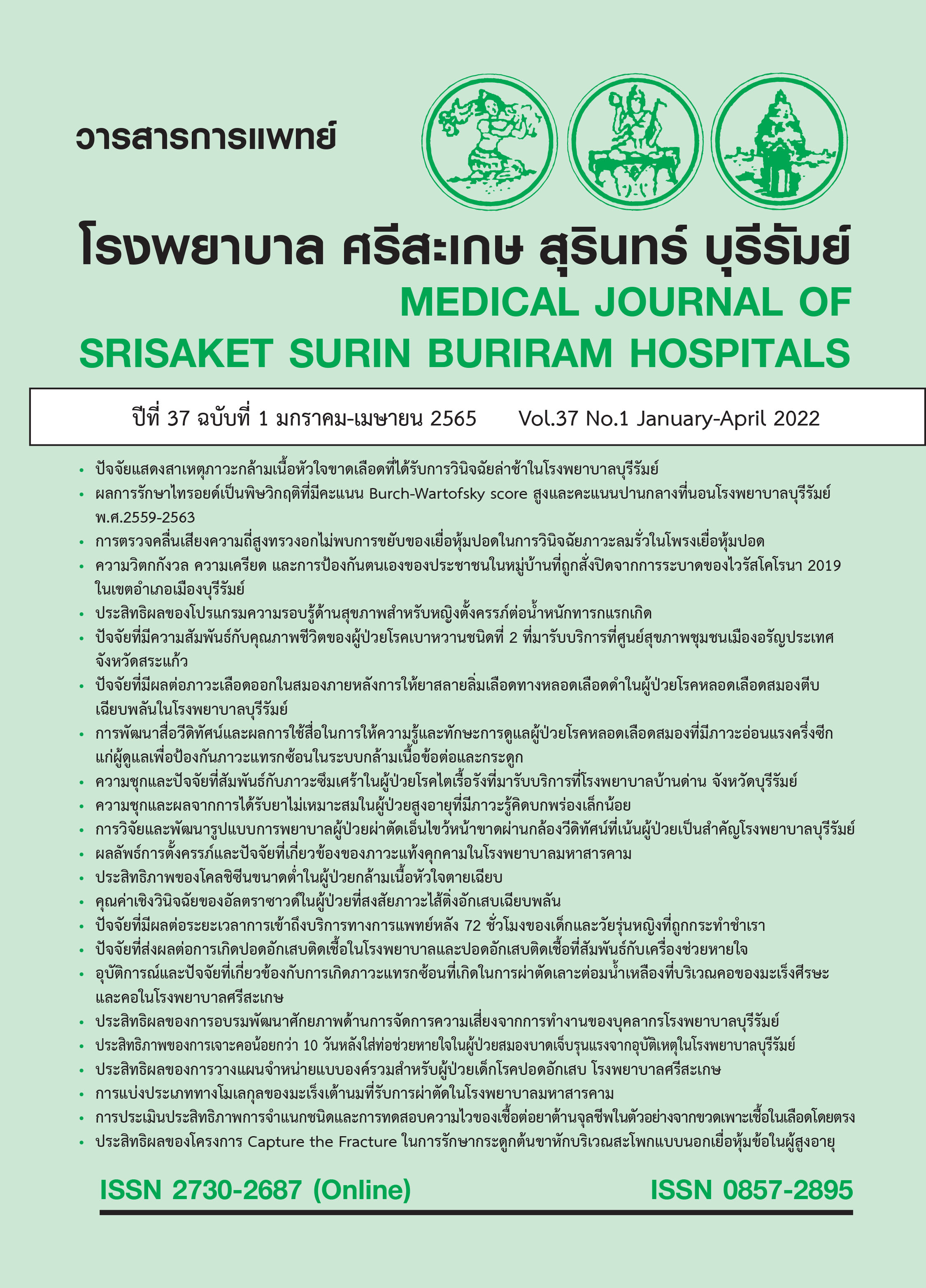การตรวจคลื่นเสียงความถี่สูงทรวงอกไม่พบการขยับของเยื่อหุ้มปอดในการวินิจฉัยภาวะลมรั่วในโพรงเยื่อหุ้มปอด
Main Article Content
บทคัดย่อ
บทนำ: ภาวะลมรั่วในโพรงเยื่อหุ้มปอด (pneumothorax) เป็นภาวะฉุกเฉินทางการแพทย์ที่พบได้บ่อย ที่ห้องฉุกเฉินและจำเป็นต้องได้รับการวินิจฉัยอย่างทันท่วงทีเพื่อลดอัตราการเสียชีวิตโดยเฉพาะในรายที่อาการไม่คงที่ซึ่งวิธีวินิจฉัยที่ถือเป็นมาตรฐานของภาวะนี้คือการเอกซเรย์คอมพิวเตอร์บริเวณทรวงอกแต่ในบริบทของโรงพยาบาลบุรีรัมย์จะใช้คลื่นเสียงความถี่สูงมาวินิจฉัยแทนเพราะมีความสะดวก รวดเร็วและบางครั้งไม่สามารถย้ายผู้ป่วยไปที่ห้องเอกซเรย์คอมพิวเตอร์ได้
วัตถุประสงค์: เพื่อศึกษาความแม่นยำในการตรวจคลื่นเสียงความถี่สูงทรวงอกในการวินิจฉัยภาวะลมรั่วในโพรงเยื่อหุ้มปอดที่ห้องฉุกเฉิน
วิธีการศึกษา: การศึกษานี้เป็น Diagnostic accuracy researchรูปแบบ retrospective cross-sectional (case-control analogue) design ในผู้ป่วยที่สงสัยภาวะลมรั่วในโพรงเยื่อหุ้มปอด ณ ห้องฉุกเฉิน โรงพยาบาลบุรีรัมย์ ตั้งแต่วันที่ 1 กันยายน พ.ศ. 2561 ถึง 30 พฤศจิกายน พ.ศ. 2563 โดยการทบทวนเวชระเบียน จำนวน 128 คน แบ่งเป็น 2 กลุ่มคือผู้ป่วยที่มีภาวะ pneumothorax 41 คนและไม่มีภาวะ pneumothorax 87 คน หาดัชนีวินิจฉัยด้านความแม่นยำและค่าการทำนา การตรวจคลื่นเสียงความถี่สูงทรวงอกในการวินิจฉัยภาวะลมรั่วในโพรงเยื่อหุ้มปอดเทียบกับเอกซเรย์คอมพิวเตอร์บริเวณทรวงอกหรือการใส่สายระบายทรวงอกได้ลมซึ่งถือเป็นวิธีวินิจฉัยที่เป็นมาตรฐาน
ผลการศึกษา: การวินิจฉัยภาวะลมรั่วในโพรงเยื่อหุ้มปอดด้วยการตรวจคลื่นเสียงความถี่สูงทรวงอกที่ห้องฉุกเฉินพบว่า Sensitivity ร้อยละ 75.6 (ระดับความเชื่อมั่นร้อยละ 9559.7-87.6), Specificity ร้อยละ 92 (ระดับความเชื่อมั่นร้อยละ 9584.1-96.7), Positive predictive values ร้อยละ 81.6 (ระดับความเชื่อมั่นร้อยละ 9565.7-92.3), Negative predictive values ร้อยละ 88.9 (ระดับความเชื่อมั่นร้อยละ 9580.5-94.5)
สรุป: การวินิจฉัยภาวะลมรั่วในโพรงเยื่อหุ้มปอดด้วยการตรวจคลื่นเสียงความถี่สูงทรวงอกมีความแม่นยำสูงจึงเหมาะในการนำมาใช้ในห้องฉุกเฉินในกรณีเร่งด่วนที่ไม่สามารถส่งเอกซเรย์คอมพิวเตอร์บริเวณทรวงอกได้อย่างไรก็ตามการตรวจ Lung sliding อย่างเดียวนั้นอาจทำให้ความแม่นยำลดลง ถ้ามีโอกาสได้ทำการศึกษาเพิ่มเติมอีกครั้งควรใช้ sign อื่นๆเพื่อเพิ่มความแม่นยำในการวินิจฉัยภาวะลมรั่วในโพรงเยื่อหุ้มปอด
Article Details

อนุญาตภายใต้เงื่อนไข Creative Commons Attribution-NonCommercial-NoDerivatives 4.0 International License.
เอกสารอ้างอิง
Chan KK, Joo DA, McRae AD, Takwoingi Y, Premji ZA, Lang E, Wakai A. Chest ultrasonography versus supine chest radiography for diagnosis of pneumothorax in trauma patients in the emergency department Cochrane Database Syst Rev 2020;7(7):CD013031. doi: 10.1002/14651858.CD013031.pub2.
Cho HY, Ko BS, Choi HJ, Koh CY, Sohn CH, Seo DW , et al. Incidence and risk factors of iatrogenic pneumothorax after thoracentesis in emergency department settings. J Thorac Dis 2017;9(10):3728-34. doi: 10.21037/jtd.2017.08.127.
Lichtenstein DA, Menu Y. A bedside ultrasound sign ruling out pneumothorax in the critically ill. Lung sliding. Chest 1995;108(5):1345-8. doi: 10.1378/chest.108.5.1345.
Blaivas M, Lyon M, Duggal S. A prospective comparison of supine chest radiography and bedside ultrasound for the diagnosis of traumatic pneumothorax. Acad Emerg Med 2005;12(9):844-9. doi: 10.1197/j.aem.2005.05.005.
Vafaei A, Hatamabadi HR, Heidary K, Alimohammadi H, Tarbiyat M. Diagnostic Accuracy of Ultrasonography and Radiography in Initial Evaluation of Chest Trauma Patients. Emerg (Tehran) 2016 Winter;4(1):29-33.
Wilkerson RG, Stone MB. Sensitivity of bedside ultrasound and supine anteroposterior chest radiographs for the identification of pneumothorax after blunt trauma. Acad Emerg Med 2010;17(1):11-7. doi: 10.1111/j.1553-2712.2009.00628.x.
Sartori S, Tombesi P, Trevisani L, Nielsen I, Tassinari D, Abbasciano V. Accuracy of transthoracic sonography in detection of pneumothorax after sonographically guided lung biopsy: prospective comparison with chest radiography. AJR Am J Roentgenol 2007;188(1):37-41. doi: 10.2214/AJR.05.1716.
Goodman TR, Traill ZC, Phillips AJ, Berger J, Gleeson FV. Ultrasound detection of pneumothorax. Clin Radiol 1999;54(11):736-9. doi: 10.1016/s0009-9260(99)91175-3.
Hwang TS, Yoon YM, Jung DI, Yeon SC, Lee HC. Usefulness of transthoracic lung ultrasound for the diagnosis of mild pneumothorax. J Vet Sci 2018;19(5):660-6. doi: 10.4142/jvs.2018.19.5.660.
Rowan KR, Kirkpatrick AW, Liu D, Forkheim KE, Mayo JR, Nicolaou S.Traumatic pneumothorax detection with thoracic US: correlation with chest radiography and CT--initial experience. Radiology 2002;225(1):210-4. doi: 10.1148/radiol.2251011102.
Alrajhi K, Woo MY, Vaillancourt C. Test characteristics of ultrasonography for the detection of pneumothorax: a systematic review and meta-analysis. Chest 2012;141(3):703-8. doi: 10.1378/chest.11-0131.
Salah AI, El-Serwi HB, Ansary AM, Houssien AB. Pleural Ultrasonography versus Chest Radiography for the Diagnosis of Pneumothorax. QJM 2021;114(Supplement 1):hcab086.004. https://doi.org/10.1093/qjmed/hcab086.004
Husain LF, Hagopian L, Wayman D, Baker WE, Carmody KA. Sonographic diagnosis of pneumothorax. J Emerg Trauma Shock 2012;5(1):76-81. doi: 10.4103/0974-2700.93116.


